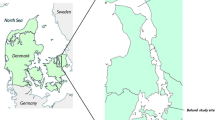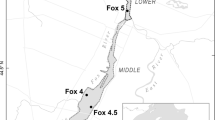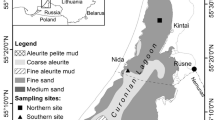Abstract
Isotopes have often been used to discern riverine subsidies to coastal food chains, but there are few direct measurements of nutritional quality of riverine particulates. We tested for nutritionally enriched organic matter in the Mississippi River suspended sediment and evidence for its delivery to Louisiana coastal sediments by measuring enzymatically hydrolysable amino acids (EHAA). Riverine suspended sediments contained EHAA concentrations of up to 5 mg g−1, higher than reported in any coastal sediment. Pigment concentrations indicated that EHAA in some river samples were dominated by phytoplankton, but many samples contained significant non-algal EHAA. Coastal sediments showed EHAA concentrations lower than riverine sediments but still higher than most reported shelf values. Incubation of riverine sediment showed losses of 28–34% of their EHAA over 6 days, similar to differences found between riverine and coastal sediments. EHAA concentrations decreased more rapidly than total nitrogen, indicating the relative lability of this pool of material in the studied region. These EHAA-enriched materials provide fuel for various coastal biota whose composition likely depends on factors such as disturbance regimes.



Similar content being viewed by others
References
Aller, J.Y., and R.C. Aller. 2004. Physical disturbance creates bacterial dominance of benthic biological communities in tropical deltaic environments of the Gulf of Papua. Continental Shelf Research 24: 2395–2416.
Alongi, D.M., and A.I. Robertson. 1995. Factors regulating benthic food chains in tropical river deltas and adjacent shelf areas. Geo-Marine Letters 15: 145–152.
Buffan-Dubau, E., and K.R. Carman. 2000. Extraction of benthic microalgal pigments for HPLC analyses. Marine Ecology–Progress Series 204: 293–297.
Carpenter, S.R., J.J. Cole, M.L. Pace, M. Van de Bogert, D.L. Bade, D. Bastviken, C.M. Gille, J.R. Hodgson, J.F. Kitchell, and E.S. Kritzberg. 2005. Terrestrial support of aquatic food webs from 13C addition to contrasting lakes. Ecology 86: 2737–2750.
Charles, F., S. Lopez-Legentil, A. Gremare, J.M. Amouroux, M. Desmalades, G. Vetion, and K. Escoubeyrou. 2005. Does sediment resuspension by storms affect the fate of polychlorobiphenyls (PCBs) in benthic food chain? Interactions between changes in POM characteristics, adsorption and absorption by the mussel Mytilus galloprovincialis. Continental Shelf Research 25: 2533–2553.
Chen, N., T.S. Bianchi, B.A. McKee, and J.M. Bland. 2004. Early diagenesis of chlorophyll-a in the lower Mississippi River and Louisiana shelf: Implications for carbon cycling in a river-dominated margin. Marine Chemistry 93: 159–177.
Corbett, D.R., B. McKee, and M. Allison. 2006. Nature of decadal-scale sediment accumulation on the western shelf of the Mississippi River delta. Continental Shelf Research 26: 2125–2140.
Dagg, M.J., and G.A. Breed. 2003. Biological effects of Mississippi River nitrogen on the northern Gulf of Mexico—A review and synthesis. Journal of Marine Systems 43: 133–152.
Dagg, M.J., T.S. Bianchi, G.A. Breed, W.-J. Cai, S. Duan, H. Liu, B.A. McKee, R.T. Powell, and C.M. Stewart. 2005. Biogeochemical characteristics of the Lower Mississippi River, USA, during June 2003. Estuaries 28: 664–674.
Darnaude, A.M., C. Salen-Picard, N.V. Polunin, and M.L. Harmelin-Vivien. 2004a. Trophodynamic linkage between river runoff and coastal fishery yield elucidated by stable isotope data in the Gulf of Lyons (NW Mediterranean). Oecologia 138: 325–332.
Darnaude, A.M., C. Salen-Picaard, and M.L. Harmelin-Vivien. 2004b. Depth variation in terrestrial particulate organic matter exploitation by marine coastal benthic communities off the Rhone River delta (NW Mediterranean). Marine Ecology–Progress Series 275: 47–57.
Dauwe, B., J.J. Middelburg, P. Van Rijswijk, J. Sinke, P.M.J. Herman, and C.H.R. Heip. 1999. Enzymatically hydrolysable amino acids in North Sea sediments and their possible implications for sediment nutritional values. Journal of Marine Research 57: 109–134.
Demopoulos, A.W.J., C.R. Smith, D.J. DeMaster, and W.L. Fornes. 2003. Evaluation of excess 234Th activity in sediments as an indicator of food quality for deep-sea deposit feeders. Journal of Marine Research 61: 267–284.
Dortch, Q., and T.T. Packard. 1989. Differences in biomass structure between oligotrophic and eutrophic marine ecosystems. Deep-Sea Research 36: 223–240.
Duan, S., and T.S. Bianchi. 2006. Seasonal changes in the abundance and composition of plant pigments in particulate organic carbon in the lower Mississippi and Pearl Rivers. Estuaries and Coasts 29: 427–442.
Duan, S., and T.S. Bianchi. 2007. Particulate and dissolved amino acids in the lower Mississippi and Pearl Rivers. Marine Chemistry 107: 214–229.
Green, R.E., T.S. Bianchi, M.J. Dagg, N.D. Walker, and G.A. Breed. 2006. An organic carbon budget for the Mississippi River turbidity plume and plume contributions to air-sea CO2 fluxes and bottom water anoxia. Estuaries and Coasts 29: 579–597.
Gremare, A., D. Butierrez, P. Anschutz, J.M. Amouroux, B. Deflandre, and G. Vetion. 2005. Spatio-temporal changes in totally and enzymatically hydrolysable amino acids of superficial sediments from three contrasted areas. Progress in Oceanography 65: 89–111.
Hackney, C.T., and E.B. Haines. 1980. Stable carbon isotope composition of fauna and organic matter collected in a Mississippi estuary. Estuarine and Coastal Shelf Science 10: 703–708.
Hedges, J.I., and F.G. Prahl. 1993. Early diagenesis: Consequences for applications of molecular biomarkers. In Organic geochemistry: Principles and applications, eds. M. H. Engel, , and S. E. Macko, 237–253. New York: Plenum.
Hitchcock, G.L., W.J. Wiseman, W.C. Boicourt, A.J. Mariano, N. Walker, T.A. Nielsen, and E. Ryan. 1997. Property fields in an effluent plume of the Mississippi river. Journal of Marine Systems 12: 109–126.
Hymel, S.N., and C.J. Plante. 2000. Fate of bacteria transiting the gut of the deposit feeder Abarenicola pacifica: Influence of temperature and sediment food concentration. Aquatic Microbial Ecology 22: 93–101.
Incze, L.S., L.M. Mayer, E.B. Sherr, and S.A. Macko. 1982. Carbon inputs to bivalve mollusks: A comparison of two estuaries. Canadian Journal of Fisheries and Aquatic Sciences 39: 1348–1352.
Ittekot, V. 1988. Global trends in the nature of organic matter in river suspensions. Nature 332: 436–438.
Ittekot, V., and S. Zhang. 1989. Pattern of particulate nitrogen transport in world rivers. Global Biogeochemical Cycles 3: 383–391.
Jumars, P.A., L.M. Mayer, J. Deming, J. Baross, and R. Wheatcroft. 1990. Deep-sea deposit-feeding strategies suggested by environmental and feeding constraints. Philosophical Transactions of the Royal Society of London–A 331: 85–101.
Keil, R.G., and M.L. Fogel. 2001. Reworking of amino acid in marine sediments: Stable carbon isotopic composition of amino acids in sediments along the Washington coast. Limnology and Oceanography 46: 14–23.
Keil, R.G., L.M. Mayer, P.D. Quay, J.E. Richey, and J.I. Hedges. 1997. Loss of organic matter from riverine particles in deltas. Geochimica et Cosmochimica Acta 61: 1507–1511.
Kimura, H., K. Harada, K. Hara, and A. Tamaki. 2002. Enzymatic approach to fungal association with arthropod guts: A case study for the crustacean host, Nihonotrypaea harmandi, and its foregut fungus, Enteromyces callianassae. Marine Ecology 23: 157–183.
Laursen, A.K., L.M. Mayer, and D.W. Townsend. 1996. The lability of proteinaceous material in estuarine seston and subcellular fractions of phytoplankton. Marine Ecology–Progress Series 136: 227–234.
Lesen, A.E. 2006. Sediment organic matter composition and dynamics in San Francisco Bay, California, USA: Seasonal variation and interactions between water column chlorophyll and the benthos. Estuarine Coastal and Shelf Science 66: 501–512.
Mayer, L.M. 1994. Surface area control of organic carbon accumulation in continental shelf sediments. Geochimica et Cosmochimica Acta 58: 1271–1284.
Mayer, L.M., L.L. Schick, T. Sawyer, C. Plante, P.A. Jumars, and R.L. Self. 1995. Bioavailable amino acids in sediments: A biomimetic, kinetics-based approach. Limnology and Oceanography 40: 511–520.
Mayer, L.M., R.G. Keil, S.A. Macko, S.B. Joye, K.C. Ruttenberg, and R.C. Aller. 1998. The importance of suspended particulates in riverine delivery of bioavailable nitrogen to coastal zones. Global Biogeochemical Cycles 12: 573–579.
Mayer, L.M., P.A. Jumars, M.J. Bock, Y.-A. Vetter, and J.L. Schmidt. 2001. Two roads to sparagmos: Extracellular digestion of sedimentary food by bacterial inoculation versus deposit-feeding. In Organism–sediment interactions, eds. Aller, J. Y., S. A. Woodin, and R. C. Aller, 335–347. Belle W. Baruch Library in Marine Science Number 21. Columbia, SC: University of South Carolina Press.
Mayer, L., L. Benninger, M. Bock, D. DeMaster, Q. Roberts, and C. Martens. 2002. Mineral associations and nutritional quality of organic matter in shelf and upper slope sediments off Cape Hatteras, USA: A case of unusually high loadings. Deep-Sea Research 49: 4587–4598.
Mayer, L.M., L.L. Schick, M. Allison, K. Ruttenberg, and S. Bentley. 2007. Marine vs. terrigenous organic matter in Louisiana coastal sediments: The uses of Bromine:organic carbon ratios. Marine Chemistry 107: 244–254.
Medernach, L., A. Gremare, J.M. Amouroux, J.C. Colomines, and G. Vetion. 2001. Temporal changes in the amino acid contents of particulate organic matter sedimenting in the Bay of Banyuls-sur-Mer. Marine Ecology–Progress Series 214: 55–65.
Mills, M.M., and K.P. Sebens. 2004. Ingestion and assimilation of nitrogen from benthic sediments by three species of Coral. Marine Biology 145: 1097–1106.
Mincks, S.L., C.R. Smith, and D.J. DeMaster. 2005. Persistence of labile organic matter and microbial biomass in Antarctic shelf sediments: Evidence for a sediment ‘food bank’. Marine Ecology–Progress Series 300: 3–19.
Moal, J., V. Martin-Jezequel, R.P. Harris, J.-F. Samain, and S.A. Poulet. 1987. Interspecific and intraspecific variability of the chemical composition of marine phytoplankton. Oceanologica Acta 10: 339–346.
Padgett, H.R. 1966. Some physical and biological relationships to the fisheries of the Louisiana coast. Annals of the Association of American Geographers 56: 423–439.
Sobczak, W.V., J.E. Cloern, A.D. Jassby, B.E. Cole, T.S. Schraga, and A. Arnsberg. 2005. Detritus fuels ecosystem metabolism but not metazoan food webs in San Francisco estuary’s freshwater delta. Estuaries 28: 124–137.
Van Heukelem, L., A.J. Lewitus, T.M. Kana, and N.E. Craft. 1992. High-performance liquid chromatography of phytoplankton pigments using a polymeric reversed-phase C18 column. Journal of Phycology 28: 867–872.
Wildish, D.J., J.E. Hughes-Clarke, G.W. Pohle, B.T. Hargrave, and L.M. Mayer. 2004. Acoustic detection of organic enrichment in sediments near salmon farms in the Bay of Fundy, Canada. Marine Ecology–Progress Series 267: 99–105.
Wissel, B., and B. Fry. 2005. Tracing Mississippi River influences in estuarine food webs of coastal Louisiana. Oecologia 144: 659–672.
Acknowledgments
We thank K. Hardy for help in the field and laboratory parts of this study. We thank two anonymous reviewers for helpful suggestions. Vessel support was provided by the Louisiana University Marine Consortium. This research was supported by the National Science Foundation (Integrated Carbon Research Program) and Office of Naval Research (DePSCOR). Contribution number 408 from the Darling Marine Center.
Author information
Authors and Affiliations
Corresponding author
Rights and permissions
About this article
Cite this article
Mayer, L.M., Schick, L.L. & Allison, M.A. Input of Nutritionally Rich Organic Matter from the Mississippi River to the Louisiana Coastal Zone. Estuaries and Coasts 31, 1052–1062 (2008). https://doi.org/10.1007/s12237-008-9080-5
Received:
Revised:
Accepted:
Published:
Issue Date:
DOI: https://doi.org/10.1007/s12237-008-9080-5




